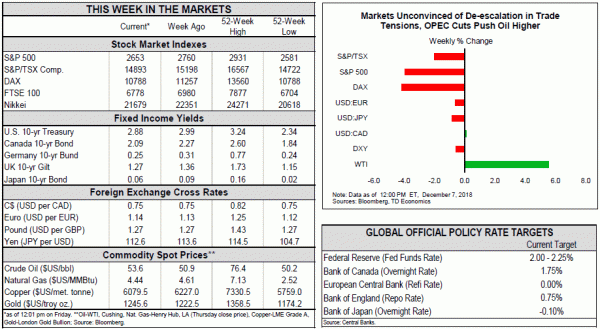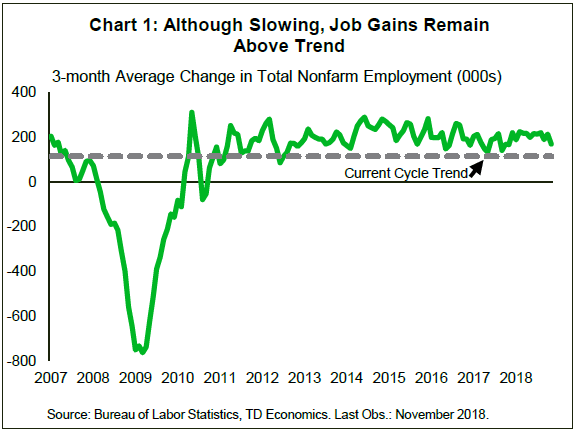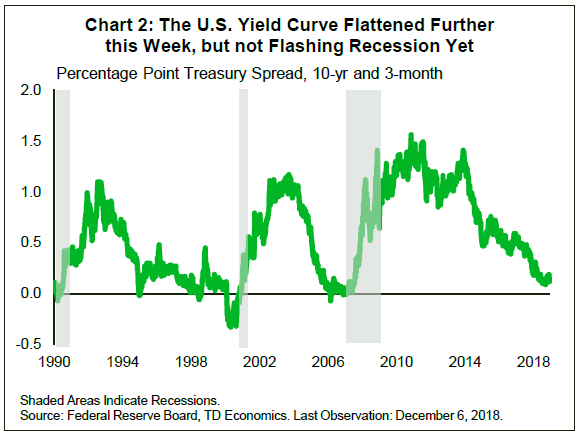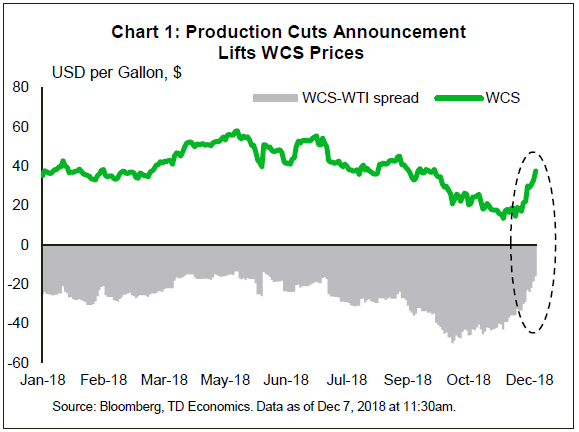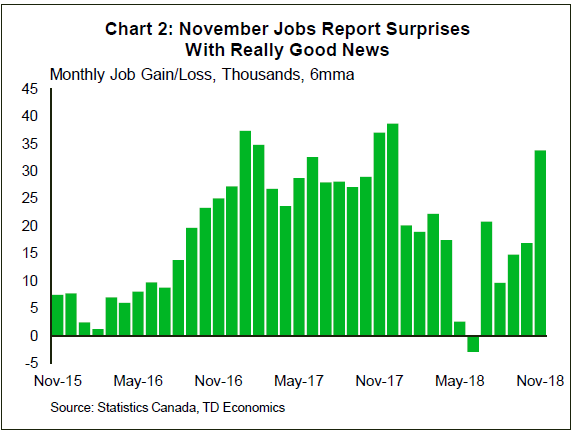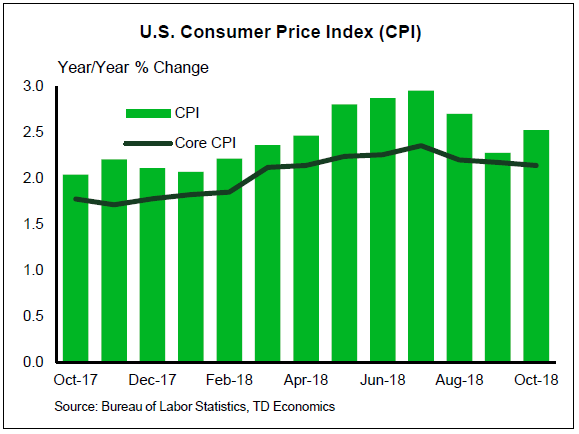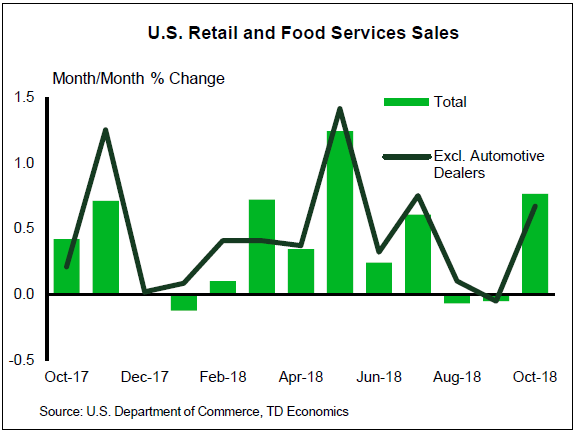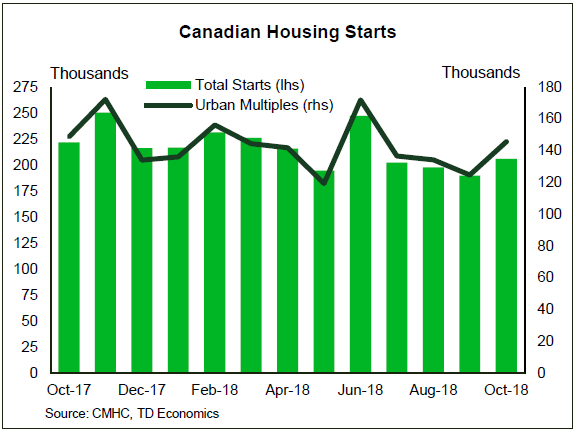U.S. Highlights
- Data released this week remains consistent with the view that U.S. economy continues to expand at an above-trend pace.
- Although disappointing in terms of the headline, job gains were also consistent with an economy running near capacity. Furthermore, wage growth held at a healthy pace in November.
- An agreement between the U.S. and China to delay an escalation of tariffs until April failed to convince financial markets that trade tensions are easing.
Canadian Highlights
- Oil prices got a lift this week. The Albertan government introduced mandatory production cuts in response to thesupply glut and pricing malaise facing
- Western Canadian oil producers. Global oil prices also got a boost on Friday after OPEC announced production cuts.
As expected, the Bank of Canada kept its overnight rate unchanged, but signaled patience and flexibility with respect to future rate hikes. - Employment numbers delivered some much-needed good news. The economy added a record 94k new jobs in November, nearly all full-time, pushing the unemployment rate to an all-time low of 5.6%.
U.S. – Markets Gyrate on U.S.-China Trade Headlines
As an event-filled week in markets concludes, indicator data this week provided an updated reading on the health of the U.S. economy. From the data released for the fourth quarter, the diagnosis is that the economic expansion continues in the U.S., with momentum slowing due to weakness in the external sector.
Manufacturing and non-manufacturing activity picked up a bit in November, but is still off the highs recorded earlier this year. Firms continue to report capacity constraints, including labor and component shortages. Import tariffs remain a key concern. Similar worries were echoed in the Fed’s latest beige book report. Respondents to the Fed’s survey for the month of November indicated that labor shortages were being felt across a broad range of industries, and that tight labor markets were preventing them from getting the workers that they needed. In addition, rising costs, although offset in part by the falling price of oil, were impacting margins and leading firms to raise prices to offset them.
Confirming these survey anecdotes of tight labor markets, this morning’s highly anticipated employment report saw 155k jobs added in November, below consensus estimates that expected an addition of 200k jobs. A steady labor force participation rate helped keep the unemployment rate at its cycle low of 3.7%. Wage growth remained healthy at 3.1% (year-on-year), the same as in October. Although the headline disappointed, the broad slowdown in job gains is in fact consistent with an economy running near capacity. We estimate that long-run trend job growth is about 100k a month, plus or minus 20k or so (Chart 1). Therefore, job gains above this level are consistent with an expanding economy and the absorption of any remaining labor market slack.
Strong fundamentals, however, are providing little comfort to financial markets. News headlines about slowing foreign demand growth, ongoing trade tensions, and Brexit have driven equity market volatility up, and prices down in the past couple of months. Fear lit a bid for bonds this week, with the U.S. 10-yr yield falling below 2.9% – its lowest level since early September. Although a flattening yield curve typically forebodes an increased chance of recession in the quarters ahead, there is little in the way of corroborating evidence (Chart 2). Instead, the recent move is likely a reflection of near-term concerns about temporary weakness in inflation and trade risks, rather than a deterioration in economic fundamentals.
Undoubtedly, an easing of trade tensions would be a welcome development. The G20 summit proved somewhat constructive as it produced a 90-day break from an escalation in import tariffs between the U.S. and China. But, news of the arrest of Huawei’s CFO later in the week revealed how fraught the relationship is currently between the U.S. and China. Tariffs appear to be just the first step in planned engagement with China on a set of deeper issues that need to be addressed.
Canada – See You in Spring, Rate Hikes
It was data galore on the Canadian economic calendar this week. The week started off with major developments in the Canadian oil sector with the Albertan government announcing mandatory production cuts in response to the pricing malaise facing Western Canadian oil producers. Output will be curtailed by roughly 325k barrels per day (bpd) during Q1 of 2019, and 95k bpd thereafter until the end of the year. The measure is meant to address large supply-demand imbalances in the market which left regional oil inventories nearly double historic norms. The announcement gave a much-needed shot in the arm to WCS prices, which are up 70% on the week to $37.5/barrel at time of writing, while WTI prices rose by just 5.7%. Nonetheless, lower production numbers will lead to a downgrade in economic growth both for Alberta and nationally.
Recent events in the oil sector have not gone unnoticed by the Bank of Canada. As widely anticipated, the Bank kept its overnight rate unchanged, but the statement released alongside the decision had a dovish tilt to it. The Bank noted that the slide in oil prices and cutbacks to production have made the outlook on Canada’s energy sector “materially weaker”.
In addition to commodity shocks, economic momentum has waned since the Bank’s last MPR in October. In a speech on Thursday, Governor Poloz noted that recent data has been on “the disappointing side”. Additionally, historic GDP revisions from Statistics Canada may suggest more economic slack than thought, also removing some of the urgency in getting the policy rate to a neutral level. Reinforcing the dovish tone (and borrowing a page from the Federal Reserve’s book), the Wednesday statement also said that the rates need to rise to a “neutral range” rather than “a neutral stance” the Bank had previously communicated. This small language tweak gives the Bank of Canada more flexibility around the end point for the tightening cycle.
To be fair, the news is not all dour. Recent tax changes, the renegotiated NAFTA agreement and capacity constraints bode well for non-energy business investment. Household credit growth and housing market are also stabilizing – an encouraging sign from a financial stability perspective.
Last but not least, we saw a record-low unemployment rate and the strongest monthly job gains (+94k, nearly all full-time) on record in the November employment report. This brought the 6-month average job gains to 34k per month – well above the 15k that we would expect in an economy running at full employment. Weak and decelerating wage growth (1.5% y/y) was the one fly in the ointment in this otherwise bright report, further reinforcing that there’s little risk to hold off hikes from the Bank of Canada’s inflation control perspective. Taking it all in, we expect the data-dependent Bank of Canada to pause with rate hikes until Spring to observe how the economy works through recent shocks and determine just how far away the light at the end of the tunnel really is.
U.S.: Upcoming Key Economic Releases
U.S. Consumer Price Index – November
Release Date: December 12, 2018
Previous: 0.3 m/m; core: 0.2% m/m
TD Forecast: 0.0% m/m; core: 0.2% m/m
Consensus: 0.0% m/m; core: 0.2% m/m
We expect headline CPI to slip to 2.2%, largely on the oil price rout which left gasoline prices down nearly 8% m/m. Beyond the energy weakness, food prices have scope to jump. We also expect a solid 0.2% print on core CPI on a pickup in core services, leaving the y/y rate higher at 2.2%. Strength in the core measure following prior weakness reinforces an upbeat report.
U.S. Retail Sales – November
Release Date: December 14, 2018
Previous: 0.8%, ex-auto: 0.7%, control group: 0.3%
TD Forecast: 0.0%, ex-auto: -0.1%, control group: 0.3%
Consensus: 0.2%, ex-auto: 0.2%, control group: 0.4%
Holiday-driven retail sales should have registered a flat monthly print in November, down from a strong 0.8% increase in October, as lower gasoline prices likely curtailed sales growth. Although solid Black Friday consumer spending represents a risk to the upside, we expect sales in the control group to have recorded a similar expansion as in the previous two months.
Canada: Upcoming Key Economic Releases
Canadian Housing Starts – November
Release Date: December 10, 2018
Previous: 205k
TD Forecast: 195k
Consensus: N/A
Housing starts are forecasted to slow to an annualized 195k in November on a moderation in multi-unit construction. Condos remain the driving force behind residential investment in Canada but we expect some giveback after a 17% increase in October. Multi-unit starts are notoriously volatile and gains of that magnitude have been followed by a 10% pullback on average going back to 2009. Single family starts are already sitting at multiyear lows and could see modest gains but any rebound should be relatively muted given continued weakness in building permit issuance.




